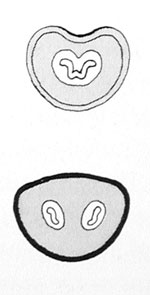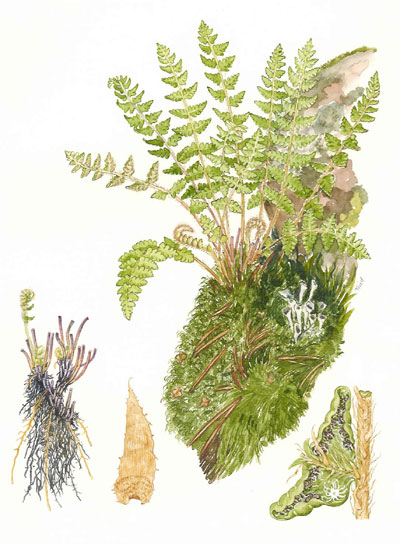| Woodsia ilvensis | ||
Rusty woodsia, oblong woodsia, rusty cliff fern | ||
|
Etymology
Ilvensis is the Latinization of Elba, the island with which Napoleon is connected.
Description
Rhizome: erect, compact, with abundant persistent petiole bases of � equal length, scales uniformly brown, lanceolate.
Frond: 20 cm high by 4 cm wide, deciduous, monomorphic, blade/stipe ratio: 1:1 to 2:1. Stipe: persistent base, brown or dark purple when mature, articulate above base at swollen node half way up the stipe, red-brown lanceolate scales at the base, a mixture of scales and hairs above and into the rachis, vascular bundles: 2, oblong, at an acute angle, at stipe base, merging above to an open u-shape. Blade: 2-pinnate at base, less divided above, narrowly lanceolate to ovate-lanceolate, broadest below middle, soft, thick, silvery-gray, shaggy below when young, rusty-brown later, rachis usually with abundant hairs and scales, lamina with linear-lanceolate scales below, and multicellular hairs concentrated along costa above. Pinnae: 10 to 20 pair, lowest somewhat reduced, sessile or nearly so; pinnules 4-9 pairs of pinnules, mostly opposite; costae grooved above, grooves continuous from rachis to costae; margins entire or crenate, often folding downwards, margins also hairy; veins free, simple or forked. Sori: round, near the margin, indusium: filamentous segments enveloping sorus, unravelling with maturity, persistent but often obscure, basal, surrounding, sporangia: brownish, maturity: midsummer. Culture
Habitat: cliffs and rocky slopes; on a variety of substrates.
Distribution: circumboreal, south to Alps, Japan, Appalachians.
Hardy to -40�C, USDA Zone 2.
Distinctive Characteristics
The pinnate-pinnatifid to 2-pinnate division separates this from the Asian species, the even stubble of old stipe bases from Ww. obtusa, oregona, scopulina, the number of pinnule pairs (more here) from W. alpina and the dense hairs and scales from W. glabella.
Synonyms
Acrostichum ilvense Linnae |
|
|
Notes
Diagnostic The Flora of North America reports white hydathodes on the upper surface in exactly the same sentence as used for describing W. obtusa. No other account mentions this diagnostic feature, and no photograph or drawing could be found showing it. – Tom
Diagnostic The Flora of North America reports white hydathodes on the upper surface in exactly the same sentence as used for describing W. obtusa. No other account mentions this diagnostic feature, and no photograph or drawing could be found showing it. – Tom

Woodsia ilvensis. Petiole cross-sections, base below, top of stipe above. �Illustration from Scandinavian Ferns by Benjamin �llgaard and Kirsten Tind, Rhodos, 1993. |
